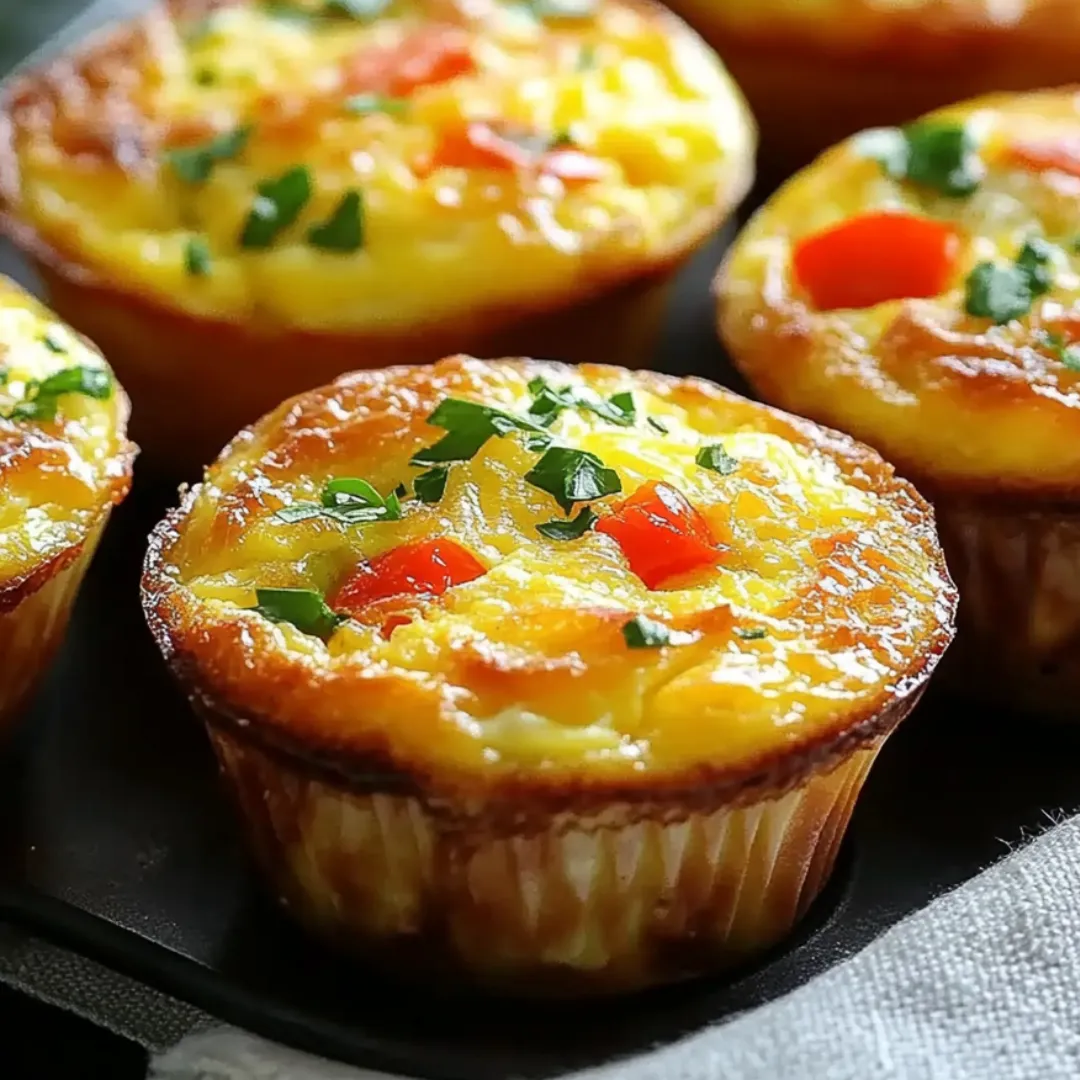 Pin it
Pin it
These make-ahead egg muffins transform mornings from hectic to hassle-free with their perfect balance of convenience and nutrition. Unlike traditional grab-and-go breakfast options that often sacrifice health for speed, these protein-rich mini frittatas combine farm-fresh eggs with colorful vegetables and savory add-ins for satisfying flavor in every bite. Their individual portioning creates the ideal texture—a tender interior with slightly crisp edges—while allowing endless customization to suit any preference or dietary need. Whether you're meal prepping for a busy week, following a specific eating plan, or simply trying to incorporate more protein into your morning routine, these versatile egg muffins deliver restaurant-quality breakfast with minimal effort and maximum convenience.
I first started making these egg muffins during an especially chaotic period when morning routines had become nearly impossible to maintain. The first weekend I prepared a batch, I was skeptical they would retain their quality through reheating. To my delight, they were just as delicious on Friday morning as they had been freshly baked! What surprised me most was how effectively they kept hunger at bay until lunchtime—something my previous on-the-go breakfasts never accomplished. My teenage son, who typically skips breakfast altogether, started grabbing two on his way out the door, and my husband now keeps a stash in his office refrigerator for busy mornings when meetings prevent a proper breakfast. The greatest testament to their appeal came when my neighbor's finicky five-year-old requested 'those yummy egg cupcakes' after trying one during a playdate. They've become such a staple in our house that Sunday afternoon now includes an egg muffin assembly line with everyone adding their preferred ingredients to personalized batches.
Essential Ingredients
- Fresh eggs: The foundation of these muffins, providing protein, structure, and rich flavor. Farm-fresh eggs with bright yellow-orange yolks create the most vibrant color and fullest flavor.
- Milk or cream: Creates a lighter, fluffier texture while adding richness. Whole milk offers the perfect balance, but any variety works—even non-dairy alternatives like almond or oat milk.
- Cheese: Adds creaminess, flavor, and helps bind the ingredients together. Sharp cheddar provides the most pronounced flavor, while mozzarella offers meltability, and feta brings tangy contrast. Pre-shredded cheese works, but freshly grated melts more smoothly.
- Vegetables: Contribute color, nutrition, and flavor variety. Bell peppers add sweet crunch and vibrant color, spinach incorporates effortless nutrition, and onions provide aromatic depth. Aim for small, uniform dice for even cooking and distribution.
- Proteins: Optional but highly recommended for heartiness and staying power. Pre-cooked bacon, ham, or sausage should be thoroughly drained of excess fat before adding. Plant-based options like crumbled tofu work beautifully for vegetarian versions.
- Seasonings: Essential for bringing all the flavors together. Salt and pepper form the foundation, while garlic powder, paprika, or dried herbs can be added for more complex flavor profiles. Season thoughtfully as cheese will add additional saltiness.
 Pin it
Pin it
Step-By-Step Preparation
- Prepare your workspace properly:
- Begin by preheating your oven to 375°F (190°C) and positioning a rack in the center for even heating. Thoroughly grease a standard 12-cup muffin tin, being especially attentive to the bottom and sides of each cup. Even when using non-stick pans, proper greasing prevents the egg muffins from sticking during baking and cooling. Silicone muffin tins or parchment liners offer additional insurance against sticking, though standard paper liners are not recommended as they tend to adhere to the eggs.
- Prepare add-ins with intention:
- If incorporating vegetables or meats, prepare them thoughtfully before mixing with eggs. Dice bell peppers, onions, and other vegetables into small, uniform pieces approximately ¼-inch in size for even distribution and proper cooking. For dense or water-rich vegetables like mushrooms, broccoli, or spinach, pre-cook briefly to remove excess moisture and ensure they're tender in the finished muffins. Sauté onions until translucent, mushrooms until they've released their moisture, and wilt spinach completely before patting dry with paper towels. For meats, ensure they're fully cooked, finely chopped, and well-drained of any excess fat to prevent greasy muffins.
- Master the egg mixture:
- In a large bowl with plenty of mixing room, crack 8 large eggs and add ½ cup of milk or cream. Whisk vigorously until completely combined and slightly frothy, incorporating air for a lighter texture. This typically takes about 60 seconds of continuous whisking. Add ½ teaspoon salt, ¼ teaspoon freshly ground black pepper, and any additional dried herbs or spices (such as ¼ teaspoon each of garlic powder, paprika, or Italian seasoning). Whisk again briefly to incorporate seasonings evenly throughout the mixture.
- Assemble with balance in mind:
- Distribute your prepared add-ins evenly among the muffin cups, filling each about halfway. For a standard recipe, use approximately ½ cup total of diced vegetables (bell peppers, spinach, onions) and ½ cup of protein additions (bacon, ham, sausage), divided between all 12 cups. Sprinkle ½ cup of shredded cheese across all muffins, reserving a small amount for topping if desired. Pour the egg mixture carefully into each cup, filling to about ¾ full to allow room for expansion. The egg should just barely cover the solid ingredients. Use a fork to gently stir each cup, ensuring ingredients are evenly distributed and not clumped together.
- Bake with precision:
- Place the filled muffin tin on the center rack of your preheated oven. Bake for 18-22 minutes, rotating the pan halfway through cooking for even browning. Watch for visual cues of doneness: the eggs should be set in the center (not jiggly), puffed up slightly, and just beginning to brown around the edges. Avoid overbaking, which can lead to tough, rubbery eggs. If you're unsure, insert a toothpick into the center of a muffin—it should come out clean when they're perfectly done.
- Cool strategically:
- Once baked, remove the muffin tin from the oven and place it on a wire rack. Allow the egg muffins to cool in the tin for exactly 5 minutes—this brief resting period lets them set up and contract slightly from the sides of the pan, making removal easier. After 5 minutes, run a butter knife or small offset spatula around the edge of each muffin to loosen it, then gently lift it out of the cup. Transfer the muffins to the wire rack to continue cooling if not eating immediately.
- Store for future enjoyment:
- Once completely cooled to room temperature (about 20 minutes), prepare egg muffins for storage. For refrigeration, place them in an airtight container with parchment paper between layers to prevent sticking. They'll keep refrigerated for up to 5 days. For longer storage, wrap each muffin individually in plastic wrap, then place in a freezer-safe zip-top bag, removing as much air as possible before sealing. Frozen egg muffins maintain quality for up to 3 months. Label the container with the date and variety of muffins for easy identification.
- Master the reheating technique:
- When ready to enjoy, reheat refrigerated muffins in the microwave for 20-30 seconds or until just warmed through. For frozen muffins, microwave for 60-90 seconds, or thaw overnight in the refrigerator before reheating. For crisper edges, place thawed muffins in a toaster oven at 325°F for 5-7 minutes. Avoid overheating, which can make the eggs tough—they should be just warmed through for the best texture and flavor.
The Art of Customization
These egg muffins serve as a brilliant canvas for creativity, allowing endless combinations to match dietary preferences, use seasonal ingredients, or simply keep breakfast interesting throughout the week. The key to successful customization lies in understanding flavor pairings and managing moisture content. For Mediterranean-inspired muffins, combine spinach, roasted red peppers, olives, and feta cheese with a pinch of dried oregano. The salty olives and tangy feta complement the eggs beautifully while minimizing additional moisture. Create a Denver omelet variation by mixing diced ham, bell peppers, onions, and cheddar cheese—a classic combination that holds up well in muffin form. Pre-cooking the peppers and onions ensures they're tender and won't release excess water during baking. For vegetable-forward muffins, incorporate pre-roasted vegetables like sweet potatoes, zucchini, and bell peppers with fresh herbs and goat cheese. Roasting concentrates the vegetables' flavors while removing excess moisture that could make the muffins soggy. Southwestern muffins feature a savory blend of cooked chorizo, black beans, corn, pepper jack cheese, and a dash of cumin. The beans provide hearty texture while the spicy chorizo and cheese create a satisfying flavor profile.
When creating your own combinations, maintain a ratio of approximately 1 cup total add-ins to 8 eggs for the perfect balance. Too many additions can prevent the eggs from setting properly, while too few may result in bland muffins.
I've made these egg muffins countless times and discovered that small adjustments can significantly impact the final result. My first batches were plagued by sticking issues until I learned the importance of thorough pan greasing—now I use a pastry brush to apply oil or butter to every crevice of each muffin cup. Another game-changer was pre-cooking vegetables, particularly mushrooms, which initially made my muffins watery until I took the time to sauté them first and drain off excess moisture. Perhaps my most useful discovery came from experimenting with texture: adding 1 tablespoon of heavy cream instead of regular milk created a silkier, more custard-like interior that reheated beautifully without becoming rubbery. For those concerned about calories, I've found that using just egg whites works well too—simply replace the 8 whole eggs with 12 egg whites for a lighter version that still holds together perfectly.
 Pin it
Pin it
Perfect Pairing Suggestions
While these egg muffins are a complete protein-packed breakfast on their own, pairing them with complementary sides creates a more substantial meal suitable for various occasions. For busy weekday mornings, grab an egg muffin alongside a piece of fresh fruit and a small yogurt for a balanced meal that covers all major food groups. The cool, creamy yogurt provides a pleasant textural contrast to the warm egg muffin. Weekend brunch calls for more elaborate pairings. Serve these muffins with roasted breakfast potatoes or hash browns for a restaurant-worthy meal. The crispy potatoes offer a satisfying contrast to the tender eggs, creating a more substantial breakfast experience. For a lighter option that still satisfies, pair with sliced avocado drizzled with lemon juice and a sprinkle of everything bagel seasoning. The creamy avocado complements the protein-rich eggs while adding healthy fats that enhance satiety. Create a breakfast-for-dinner spread by serving egg muffins alongside a simple green salad dressed with vinaigrette. The fresh, acidic notes of the salad balance the richness of the eggs, making for a light yet satisfying evening meal. For entertaining, arrange a variety of egg muffin flavors on a platter surrounded by fresh fruit, mini muffins, and a yogurt parfait bar. This interactive spread allows guests to customize their breakfast plate while still maintaining an elegant presentation.
My final thought on these egg muffins is that they perfectly embody what I love most about practical home cooking—they solve a real everyday problem while still delivering exceptional flavor and nutrition. There's something deeply satisfying about opening the refrigerator on a busy morning and finding a homemade breakfast waiting that requires just seconds to reheat. Beyond their practical benefits, these muffins showcase how simple ingredients can be transformed into something that feels special through thoughtful preparation and personalization. Whether you're feeding a family with diverse preferences or simply trying to streamline your own morning routine, these versatile egg cups prove that convenience doesn't have to come at the expense of quality or nutrition. In our household, they've become not just a breakfast solution but a symbol of self-care—a small way of looking out for our future selves when mornings become too hectic to prepare a proper meal.
Frequently Asked Questions
- → How long do egg muffins last in the refrigerator?
- Properly stored in an airtight container, egg muffins will last 3-4 days in the refrigerator. Perfect for meal prepping at the beginning of the week!
- → Can I freeze these egg muffins?
- Yes! Cool them completely, then freeze individually wrapped or in a freezer-safe container for up to 2 months. Reheat from frozen in the microwave for 1-2 minutes.
- → What's the best way to reheat egg muffins?
- For best results, microwave refrigerated egg muffins for 20-30 seconds or frozen ones for 1-2 minutes. You can also reheat them in a toaster oven at 350°F for about 5 minutes.
- → Can I make these dairy-free?
- Absolutely! Skip the milk and cheese or use plant-based alternatives. The egg muffins will still be delicious with just vegetables and seasonings.
- → Why did my egg muffins deflate after baking?
- This is normal! Egg muffins puff up during baking and naturally deflate a bit as they cool. They'll still taste great and maintain their basic structure.
